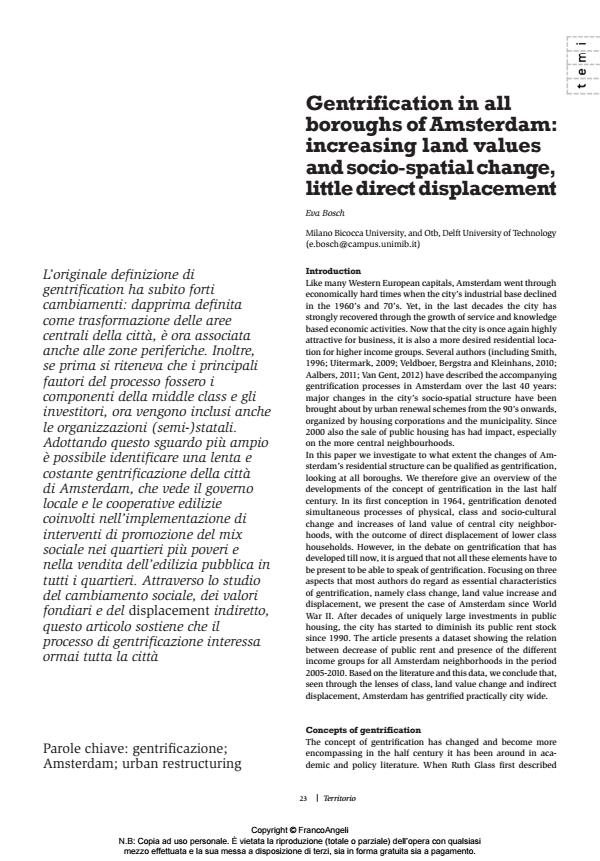Gentrification in all boroughs of Amsterdam: increasing land values and socio-spatial change, little direct displacement
Titolo Rivista TERRITORIO
Autori/Curatori Eva Bosch
Anno di pubblicazione 2015 Fascicolo 2015/73 Lingua Italiano
Numero pagine 7 P. 23-29 Dimensione file 248 KB
DOI 10.3280/TR2015-073004
Il DOI è il codice a barre della proprietà intellettuale: per saperne di più
clicca qui
Qui sotto puoi vedere in anteprima la prima pagina di questo articolo.
Se questo articolo ti interessa, lo puoi acquistare (e scaricare in formato pdf) seguendo le facili indicazioni per acquistare il download credit. Acquista Download Credits per scaricare questo Articolo in formato PDF

FrancoAngeli è membro della Publishers International Linking Association, Inc (PILA)associazione indipendente e non profit per facilitare (attraverso i servizi tecnologici implementati da CrossRef.org) l’accesso degli studiosi ai contenuti digitali nelle pubblicazioni professionali e scientifiche
L’originale definizione di gentrification ha subito forti cambiamenti: dapprima definita come trasformazione delle aree centrali della città, è ora associata anche alle zone periferiche. Inoltre, se prima si riteneva che i principali fautori del processo fossero i componenti della middle class e gli investitori, ora vengono inclusi anche le organizzazioni (semi-)statali. Adottando questo sguardo più ampio è possibile identificare una lenta e costante gentrificazione della città di Amsterdam, che vede il governo locale e le cooperative edilizie coinvolti nell’implementazione di interventi di promozione del mix sociale nei quartieri più poveri e nella vendita dell’edilizia pubblica in tutti i quartieri. Attraverso lo studio del cambiamento sociale, dei valori fondiari e del displacement indiretto, questo articolo sostiene che il processo di gentrificazione interessa ormai tutta la città;
Keywords:Gentrificazione; Amsterdam; urban restructuring
- Aalbers M., 2011, «The Revanchist Renewal of Yesterday’s City of Tomorrow », Antipode, vol. 43, n. 5, pp. 1696-1724. DOI: 10.1111/j.1467-8330.2010.00817.x
- Bureau Parkstad, 2004, Richting Parkstad 2015, Gemeente Amsterdam, Amsterdam.
- Doucet B., 2009, «Living through Gentrification: Subjective Experiences of Local, Non-gentrifying Residents in Leith, Edinburgh», Journal of Housing and the Built Environment, vol. 24, n. 3, pp. 299-315. DOI: 10.1007/s10901-009-9151-3
- Davidson M., Lees L., 2010, «New-build Gentrification: Its Histories, Trajectories and Critical Geographies», Population, Space and Place, vol. 16, n. 5, pp. 395-411. DOI: 10.1002/psp.584
- Glass R., 1964, «Introduction: Aspects of Change», in Glas R. (ed.), London: Aspects of Change, MacGibbon and Kee, London.
- Hackworth J., 2002, «Postrecession Gentrification in New York City», Urban Affairs Review, vol. 37, n. 6, pp. 815-843. DOI: 10.1177/107874037006003
- Hackworth J., Smith N., 2001, «The Changing State of Gentrification», Tijdschrift Voor Economische En Sociale Geografie, vol. 92, n. 4, pp. 464-477. DOI: 10.1111/1467-9663.00172
- Amsterdamse Huurdersvereniging, 2014, Open brief aan de formateurs van het nieuwe bestuurscollege van Amsterdam (www.huurdersvereniging-amsterdam.nl/open-brief-aan-d66-en-groenlinks/).
- Joseph M., Chaskin R., Webber H., 2007, «The Theoretical Basis for Addressing Poverty Through Mixed-Income Development», Urban Affairs Review, vol. 42, n. 3, pp. 369-409. DOI: 10.1177/1078087406294043
- Kantor P., Savitch H.V., 2002, Cities in the International Marketplace, Princeton U.P., New Jersey.
- Kleinhans R., 2004, «Social Implications of Housing Diversification in Urban Renewal: A Review of Recent Literature», Journal of Housing
- and the Built Environment, vol. 19, n. 4, pp. 367-390. DOI: 10.1007/s10901-004-3041-5
- Kleinhans R., 2005, Sociale implicaties van herstructurering en herhuisvesting, Ios Press, Delft.
- Kloosterman R., 1994, «Amsterdamned: The Rise of Unemployment in Amsterdam in the 1980s», Urban Studies, vol. 31, n. 8, pp. 1325-1344. DOI: 10.1080/00420989420081181
- Lees L., 2008, «Gentrification and Social Mixing: Towards an Inclusive Urban Renaissance?», Urban Studies, vol. 45, n. 12, pp. 2449-2470. DOI: 10.1177/0042098008097099
- Marcuse P., 1986, «Abandonment, Gentrification and Displacement: The Linkages in New York City», in Smith N., Williams P. (eds.), Gentrification of the City, Allan & Unwin, Boston.
- Ouwehand A., van Daalen G., 2002, Dutch Housing Associations: A Model for Social Housing, Ios Press, Delft.
- O&S Amsterdam, 2011, Amsterdam Vitale Stad, Gemeente Amsterdam, Amsterdam.
- O&S Amsterdam, 2012, Amsterdam in cijfers, Dienst O&S, Amsterdam.
- Scp & Cbs, 2013, Armoedesignalement 2013. Cbs, Den Haag.
- Slater T., 2006, «The Eviction of Critical Perspectives from Gentrification Research», International Journal of Urban and Regional Research, vol. 30, n. 4, pp. 737-757. DOI: 10.1111/j.1468-2427.2006.00689.x
- Smith N., 1979, «Toward a Theory of Gentrification a Back to the City Movement by Capital, not People», Journal of the American Planning Association, vol. 45, n. 4, pp. 538-548. DOI: 10.1080/01944367908977002
- Smith N., 1996, The New Urban Frontier: Gentrification and the Revanchist City, Routledge, New York.
- Uitermark J., Duyvendak J.W., Kleinhans R., 2007, «Gentrification as a Governmental Strategy: Social Control and Social Cohesion in Hoogvliet, Rotterdam», Environment and Planning A, vol. 39, n. 1, pp. 125-141. DOI: 10.1068/a39142
- Uitermark J., 2009, «An in Memoriam for the Just City of Amsterdam», City, vol. 13, n. 2-3, pp. 347-361. DOI: 10.1080/13604810902982813
- Van der Veer J., Schuiling D., 2005, «The Amsterdam Housing Market and the Role of Housing Associations», Journal of Housing and the Built Environment, vol. 20, n. 2, pp. 167-181. DOI: 10.1007/s10901-005-9004-7
- Van Gent W., 2012, «Neoliberalization, Housing Institutions and Variegated Gentrification: How the ‘Third Wave’ Broke in Amsterdam», International Journal of Urban and Regional Research, vol. 37, n. 2, pp. 503-522. DOI: 10.1111/j.1468-2427.2012.01155.x
- Van Gent W., Boterman W., 2012, «Housing Liberalization and Gentrification - The Social Effects of Tenure Conversions in Amsterdam», Tijdschrift voor Economische en Sociale Geografie, vol. 105, n. 2, pp.
- 130-150. DOI: 10.1111/tesg.12050
- Van Veghel M., Wassenberg F., 1999, Stedelijke vernieuwing in de Bijlmermeer. Bewoners over de toekomst van Grubbehoeve en Grunder, Delft U.P., Delft.
- Veldboer L., Bergstra M., Kleinhans R., 2011, Meer inkomensdiversiteit, meer buurtvertrouwen? Sociale tectoniek of vreedzame co-existentie in Amsterdamse gentrification-wijken, Nicis, Den Haag
Eva Bosch, Gentrification in all boroughs of Amsterdam: increasing land values and socio-spatial change, little direct displacement in "TERRITORIO" 73/2015, pp 23-29, DOI: 10.3280/TR2015-073004